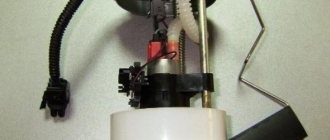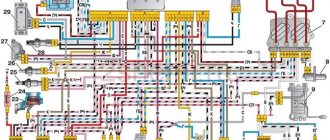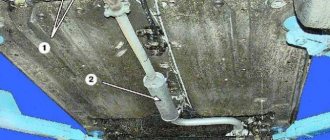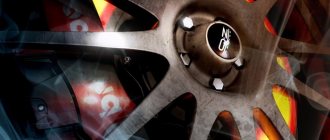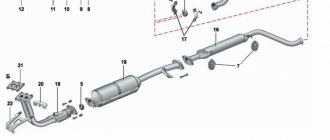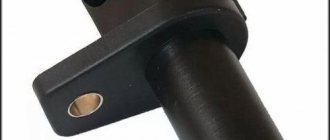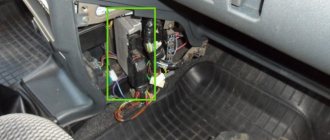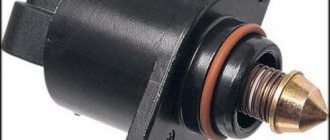We continue to prepare for the summer season!
I couldn’t resist, I wanted to show some nice things) a little out of plan, but such chic things cannot be hidden)
I've been wanting a new exhaust system for a long time. The standard has long since exhausted itself, the ringing of metal began and there was a constant knocking on the bottom, in the area of the rear passengers, it seemed to be knocking on the beam. In short, I'm fed up with this standard. I bought all kinds of rubber bands and put iron clamps in their place, the knocking noise disappeared for a while, then it appeared again. It's all because of the suspension, the beam is too close to the pipe. Also, fastenings and so-called rubber donuts are not suitable, they are not provided for by the design))
The only solution was to change the entire system. The new exhaust system had to have the following qualities. Firstly, I don’t like direct flow with PROSport cans, it’s too loud, but there’s NO SENSE! Secondly, there must be normal fastenings so that nothing knocks! Thirdly, it should not stick out from under the bumper, IMHO KOLOKHOZ))
Well, the price should be acceptable for
RUSSIAN
car.
This is what I managed to find and order and have already received) I ordered on the website stinger-shop.ru/ all on 51 pipes
Main muffler for VAZ 2113, VAZ 2114 vehicles without attachment for standard installation
Car model: VAZ 2113, VAZ 2114 Engine capacity: from 1500 cm3 Material: steel 08 PS, used for the manufacture of high-quality exhaust systems, powder coating. Dimensions: pipe diameter 51 mm, barrel diameter 120 mm, barrel length 480 mm, wall thickness 1.5 mm Installation: installation with a standard resonator or Stinger resonator is carried out without welding. Advantages: Installing this direct-flow muffler on a car gives an increase in power. Can be used as a replacement for a failed standard muffler. Additional information: filling - basalt wool and basalt fabric (heat resistance 1200 degrees C) to prevent the wool from blowing out. During installation, standard clamps are used, the tip is technical stainless steel. Warranty: 6 months.
The exhaust system, or, as it is also called, the exhaust gas system of the VAZ 2114, is a communication system through which gases pass from the car’s engine to the outside. This path starts from the intake manifold, then goes into the exhaust pipe, and then through the converter into the mufflers (main and additional). The neutralizer is equipped with reliable protection from various thermal effects in the form of a steel heat-insulating screen.
Connecting elements of the structure
The design of the exhaust system of the VAZ 2114 includes elements that connect its parts into a single and continuous “pipeline”: 1. Sealing gasket - connects the exhaust pipe and the manifold. 2. Movable hinge – used to connect the converter flange and the exhaust pipe. 3. Metallographic ring - installed between the flanges. 4. Cone rings and a clamp with flared ends are the connecting parts between the muffler pipes. 5. Nuts (disposable) on the walls of the bracket and studs of the manifold - secure the exhaust pipe. Let's look at what parts the VAZ 2114 exhaust system consists of in more detail.
Tuning the gas exhaust system
The exhaust system of the VAZ 2114 also allows you to increase the power of the vehicle's power unit thanks to the installation of forward flow. The engine is boosted by accelerating the exhaust gases.
The principle of operation of direct-flow systems involves the creation of a rarefied atmosphere in which flows flow faster from the combustion chamber into the fuel cylinders. Increasing speed proportionally increases power, creating the necessary resistance.
Its value reaches about 10% above what is initially included in the technical characteristics of the exhaust unit without a direct-flow unit.
In a standard muffler, the resistance rate is much higher - 60-70%, which significantly slows down the release of exhaust gases. Equipping with such a unit also increases engine power by 6%. It is important to note that this happens without any structural changes to the gas exhaust system, which often require substantial investment.
Diagram for 1.6 l engines
The exhaust system of cars equipped with 1.6 liter engines is distinguished by the fact that it does not contain a neutralizer; this element is replaced by a metal “corrugation”. The exhaust system of the 1.6-liter VAZ 2114 is also equipped with a catalytic manifold, which is mounted after the sealing gasket (3). Let's add a few words about the fastening of the entire structure - it is suspended from the bottom of the car on five suspension cushions, and its component parts are connected to each other using gaskets, O-rings and clamps. And some more information for your information - the exhaust system of VAZ 2115, 14, and 13 has a toxicity standard of R 83.
VAZ cars of the 14th and 15th models are still in demand among Russian drivers today. The machines are easy to use, do not require vigilant attention and rarely require repairs. However, they also have a “sore spot” - the mufflers. Therefore, VAZ 2114/2115 owners need to be prepared for the fact that sooner or later they will have to repair or replace the silencer on their car.
Useful tips
Finally, here are some useful tips that will help your car muffler last longer.
- Inspect the exhaust system at least once a month. This will allow you to timely detect existing problems and eliminate them through minor repairs.
- Try to avoid sudden cooling of the muffler while the engine is running. This way you will protect it from premature corrosion.
- Check the attachment of the muffler to the bottom. Excessive vibration will not have a positive effect on its condition.
- Monitor the performance of the oxygen sensor, because the amount of oxygen in the combustible mixture depends on its information. If its correct concentration is violated, it can burn out in the exhaust manifold or even in the catalyst.
- If you really had to buy a muffler, choose a model with optimal quality and price.
What is a car muffler for?
Regardless of the make and year of manufacture of the car, all its systems serve one purpose - to ensure stable operation of the engine and movement. The exhaust system may seem insignificant compared to systems such as the brakes or fuel. However, it is the vehicle's exhaust system that has the most direct impact on engine performance.
The muffler is an integral part of the exhaust system . Its main purpose is to remove exhaust gases outside the car. In addition, the part also serves to reduce noise, since residual fuel can burn in the exhaust system pipes.
The pipe comes out from the rear left side of the car
How to attach
The muffler on the VAZ 2114/2115 is attached to the car body. To ensure that the pipe is securely fixed and does not vibrate during movement, two fastening methods are used:
on rubber suspensions.
Bolts and nuts for fastening the muffler pipes are made of special heat-resistant alloys
The muffler is attached directly to the exhaust manifold with bolted connections, which guarantee complete tightness of the joints. The middle part is also fixed with bolts and nuts. And the resonator and exhaust pipe are suspended on special hooks on the bottom with elastic bands. These suspensions are easy to remove and put on, but at the same time provide rigidity even when driving on uneven roads.
Schematic design of the exhaust system on a VAZ 2114/2115
The gas exhaust system of the VAZ 2114/2115 consists of several parts. Connecting to each other in series, all parts ultimately serve one purpose - reducing noise and removing exhaust emissions outside the body.
1 — bracket for fastening the exhaust pipe; 2 - gasket; 3 — clamping device for the bracket; 4 — additional muffler; 5.7 — “pillows” for muffler suspension; 6 — main muffler; 8 — clamp connecting the muffler pipes; 9 - neutralizing device; 10 — hinge sealing ring; 11 - sensor that monitors the oxygen concentration in emissions; 12 — exhaust pipe for mufflers
Symptoms of a problem
The car itself will tell you when the muffler needs to be replaced. You just need to listen for the characteristic signs of its malfunction:
- Noise increases when the engine is running;
- There is an exhaust smell inside the cabin or near the car;
- Exhaust gas smoke comes out from under the bottom due to the formation of a hole in the exhaust system.
How to replace a muffler on a VAZ 2114/2115
If you start having any problems with the muffler, it is better not to put it off for a long time. The life and health of the driver and passengers depends on how correctly the “glushak” works. In general, the replacement process itself begins with the selection of a new exhaust system kit. It is best not to save money, but to purchase an original factory one. This will delay the need for repeated replacement indefinitely.
In addition, it is recommended to change the fastening bolts during each replacement. It is necessary to choose products made from heat-resistant materials, since otherwise the bolts will quickly stick to the bottom and will be impossible to unscrew.
Official recommendations
Naturally, the manufacturer recommends installing silencers made by AvtoVAZAgregat of the appropriate modification. The recommendations are justified by the following arguments:
- Compared to competitive products, jammers weigh more. According to factory workers, this means that their walls are thicker and will last longer (3-5 times, according to the manufacturer).
- The insides of the muffler are filled with special cotton wool, which collects condensation and prevents it from causing corrosion.
How to repair a “glushak” with your own hands
The muffler on the “fourteenth” and “fifteenth” is considered one of the most vulnerable points of the car. The fact is that due to exposure to high temperatures, the metal quickly burns out, that is, the tightness of the system is broken. Therefore, the part must be changed as soon as there is a suspicion that it is not working.
Reasons for failure
Most often, mufflers “burn out” - that is, due to hot exhaust, the metal inside the housing begins to thin out, which ultimately leads to the appearance of holes. However, this is not the only reason why the silencer may fail:
using a homemade device - handicraft products do not differ in quality and long service life;
mechanical shocks from uneven roads - dents and deformations of the pipe also lead to loss of tightness;
Rust and corrosion sooner or later affects even the highest quality original mufflers.
In general, all of the above factors influence service life to some extent. The car owner can easily identify all of the above faults - just drive the VAZ into the inspection hole and visually examine the muffler. In addition, when deformations, burnouts and corrosion reach their “peak”, the part will begin to make characteristic sounds when moving - gurgling, sharp pops, knocking.
Why is the muffler knocking?
This part on the VAZ 2114/2115 can make knocking noises only in two cases:
it hits the body;
When moving, it touches the gas tank housing.
In any case, it is necessary to immediately take measures to eliminate this malfunction. Most often, the problem lies in severe wear of the rubber suspensions. It is enough to change them and the muffler will again return to its normal position under the bottom of the car.
Reasons for part failure
The muffler is affected by several different factors that can lead to failure, these are:
- Atmospheric precipitation, dirt. Precipitation means the occurrence of rain and snow. A mass that periodically falls on a hot pipe causes temperature changes, destroying the strength of the metal. Unfortunately, it will not be possible to protect the muffler in any way; moisture will in any case affect the metal. A smart solution would be to avoid driving through deep puddles and drive slowly on contaminated sections of the road. If the muffler and pipe are dirty, it is necessary to clean it with water (you can use a pressure jet from a hose). After cleaning, it is recommended to start the engine so that any water that has entered the muffler evaporates.
- Condensate. When the unit is idle for a long time, condensation forms in the muffler, causing a corrosive process. This leads to inevitable destruction of the internal parts of the muffler. This happens extremely rarely, but before the trip it is recommended to increase the operating speed by pressing the accelerator several times. The flow of exhaust gases removes moisture from the silencer.
- Chemical influence. As a result of the release of exhaust gas, a lot of toxic chemical particles settle on the walls of the muffler, destroying the metal, and allowing road reagents to get into the muffler.
- Physical influence. Hitting stones and blows from the muffler when driving on roads also lead to a lot of damage.
The chemical and physical effect on the muffler metal is a natural process. It will not be possible to disassemble and clean the muffler, since the container cannot be opened, and only the attention and professionalism of the driver on the road will help protect it from impacts and stones. Diagnosing and repairing minor damage at the initial stage will help avoid serious problems in the future.
The influence of various negative factors can lead to damage to the corrugation or other parts of the muffler
